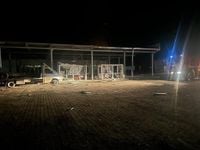Russian missile and drone strikes have once again rattled Ukraine, leaving a trail of destruction, civilian casualties, and international concern in their wake. Between November 19 and 22, 2025, a series of attacks targeted regions across the country, from the western city of Ternopil to the southern oblasts of Kherson, Donetsk, and Odesa. The violence not only claimed dozens of lives but also drew in neighboring countries as the conflict spilled toward international borders.
On November 19, a Russian missile strike devastated the city of Ternopil in western Ukraine, hundreds of kilometers from the front lines. As reported by The Kyiv Independent, the attack killed at least 33 people, including six children. Among the dead was a seven-year-old Polish citizen named Amelia, who perished with her mother. Poland’s Prime Minister Donald Tusk expressed profound grief, writing, “Amelka was seven years old. Seven. A Polish child. She died in Ternopil during a brutal Russian missile attack. She will no longer fulfill any of her dreams. This cruel war must end, and Russia cannot win it. Because this is also a war about the future of our children.”
The human cost of the Ternopil strike was staggering. Ninety-four people were injured, including 18 children, and two nine-story apartment buildings sustained severe damage. Interior Minister Ihor Klymenko described the aftermath in harrowing terms: “I walked between the burnt walls — it was a terrible feeling. In each apartment — a whole life that Russia destroyed in an instant.” Some residents, desperate to escape the flames, leaped from upper-floor windows.
Search and rescue operations in Ternopil lasted four days, ending on November 22. Emergency workers rescued 46 people, including seven children, and even managed to save three pets. Yet six people remain missing, among them a child. The Ukrainian Air Force confirmed that Kh-101 missiles, launched from Russian aircraft in the Vologda and Astrakhan regions, were used in the strike. Local authorities declared November 19–21 as days of mourning, canceling all entertainment events and lowering flags to half-mast. The Security Service of Ukraine has classified the attack as a war crime, opening a criminal case under Article 438 of the Ukrainian Criminal Code.
The tragedy in Ternopil was compounded by environmental hazards. The Ternopil Oblast Military Administration warned that the level of toxic substances in the city’s air had risen to six times the normal limit after the strike, urging residents to stay indoors and keep windows closed.
While the west mourned, southern Ukraine was under siege. Overnight between November 21 and 22, Russian forces launched attacks on Kherson, Donetsk, and Odesa regions, as detailed by BBC and other outlets. In Kherson, three apartment blocks and 14 private homes were damaged, resulting in six injuries. Donetsk saw further bloodshed: a resident of Holubivka was killed, and another person was injured in Kostiantynivka.
The Odesa region was not spared. Regional governor Oleh Kiper reported that Russian forces carried out a large-scale strike on civilian infrastructure, damaging building facades, roofs, and windows of administrative buildings. Eleven trucks parked nearby were also hit. Two people were injured and are receiving medical care. The strikes occurred despite active Ukrainian air defense efforts.
But the violence did not stop at Ukraine’s borders. In the early hours of November 22, Romania scrambled F-16 fighter jets after Russian air strikes hit southern Odesa Oblast near the Ukraine-Romania border, according to Digi24. Air raid sirens blared at 1:33 am in northern settlements of Tulcea County when Russian strike drones were detected near Izmail, Ukraine. The Romanian Ministry of Defense confirmed that two F-16s were deployed to monitor airspace but emphasized that there were no violations of Romanian airspace. The jets returned to Borcea Air Base at 3:42 am.
“We are in permanent contact with our allies, we exchange operational information in real time and we act decisively to guarantee the security of Romania and NATO’s eastern flank,” the ministry said in a statement. The response underlined the growing anxiety among NATO members as the conflict edges closer to their territories.
One of the most significant incidents involved the Orlivka border crossing between Ukraine and Romania. Russian strike drones attacked the ferry terminal and key infrastructure at Orlivka early on November 22, damaging the complex and forcing officials to suspend operations. The crossing, a major checkpoint for freight, passenger, and private vehicles, has been targeted multiple times since Russia’s full-scale invasion began. It was previously closed in October 2023 and October 2024 following similar attacks. Ukrainian authorities have urged travelers to use alternative crossings while repairs are underway.
Odesa regional governor Oleh Kiper described the latest attack, saying, “Facades, roofs and windows of administrative buildings were hit. Eleven trucks were damaged in a parking area, and two people were injured. They are receiving medical help.” The repeated targeting of border infrastructure not only disrupts humanitarian and commercial traffic but also raises the risk of accidental escalation with NATO neighbors.
Earlier in the week, a Russian drone flew over Romanian and Moldovan territory during another massive barrage against Ukraine. Poland, too, responded by scrambling aircraft and temporarily closing airports in Rzeszów and Lublin. On November 17, several Romanian villages along the Danube had to be evacuated after a fire broke out on an LPG tanker near the Ukrainian shore, again following Russian strikes.
As the attacks have intensified, so too has international condemnation. The targeting of civilians, including children, and repeated assaults on critical infrastructure and border crossings have been widely denounced by Ukrainian authorities and neighboring governments. The Security Service of Ukraine’s decision to classify the Ternopil attack as a war crime signals Kyiv’s determination to pursue accountability, even as the conflict grinds on.
For ordinary Ukrainians, the latest wave of violence has brought fresh trauma and uncertainty. In Ternopil, residents held a minute of silence, bearing posters with slogans like “Remember” and “Adults and children” to honor the victims. In Odesa, Kherson, and Donetsk, families are once again picking up the pieces, tending to the wounded, and mourning the dead. Meanwhile, the threat of further escalation looms, as NATO countries remain on high alert and Ukraine braces for more attacks.
In a conflict that has already exacted a staggering human toll, the events of this week serve as a stark reminder that the war’s reach is growing—and that its consequences are being felt far beyond Ukraine’s battle-scarred front lines.





